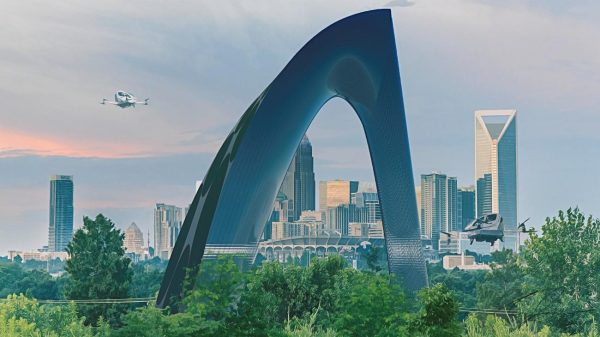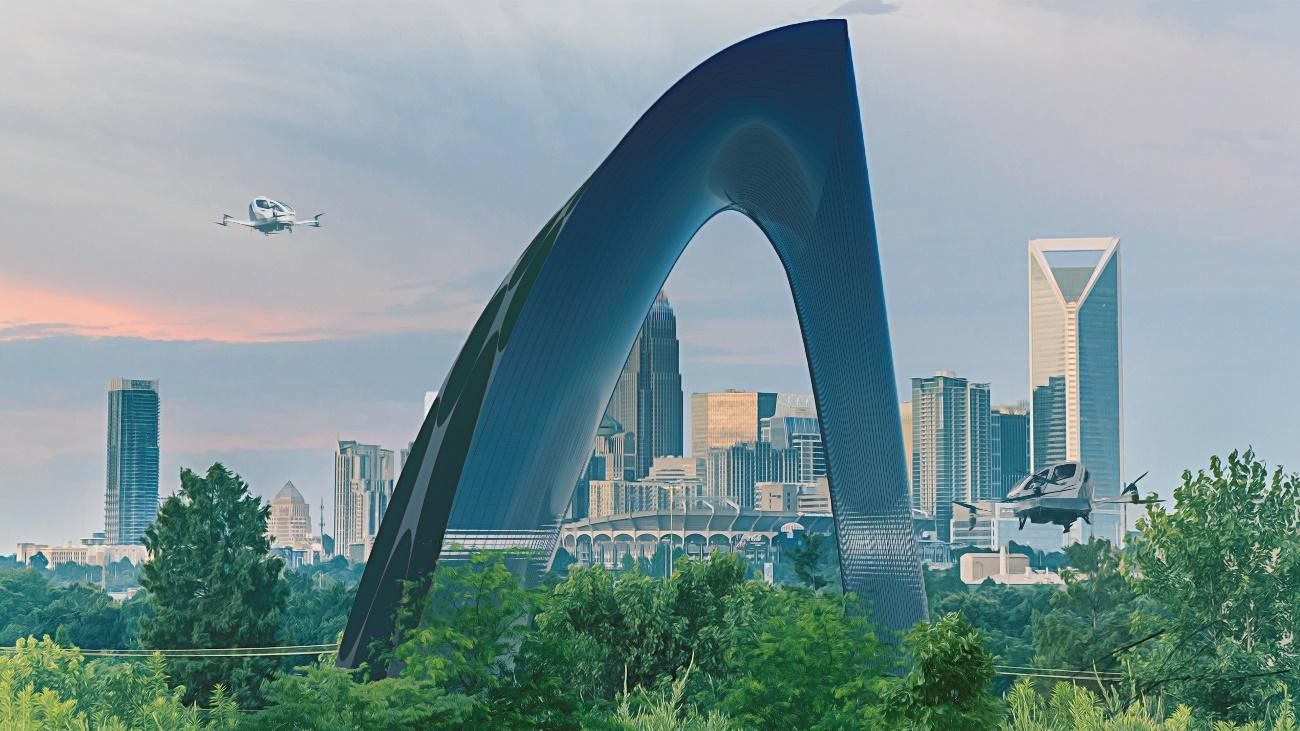The Next City: Is this what Charlotte should look like 20 years from now?

Charlotte is one of the fastest growing city in the United States. With the city’s expanding population and surging development, there is a need for revolutionary changes to address the growth of the coming years. Over the past year, a group of multidisciplinary designers called “Curators“ have been working on a macro- and micro-level to present research on the city’s growth, identify potential areas of development, and offer suggestions for how the city may continue to serve its growing population.
The team’s initial studies included research about ‘developed cities’ nationally and internationally, supplemented by reading journals, articles and books on the evolution and growth of global cities. The United Nations states there are currently three billion people living in cities across the world – this population is expected to increase up to six billion within the next 15-20 years. To meet the expectations of this growing population, cities will need to evolve, or will be left behind. While there are several challenges for leading cities to address, this population growth offers a wealth of opportunities and possibilities for development. Therefore, cities need to be futuristic in their outlook. That’s why Curators, as a small team of multidisciplinary designers from across the globe, are sharing ‘The Next City’ – their vision for a radical new type of building in the City of Charlotte, for twenty years from now.
In this visionary representation, an entire building façade is covered with transparent solar panels, providing energy to both the building and the city at large. The building’s shape is explicitly oriented to maximize the capture and use of rainwater and embed vertical agriculture. A building like this would potentially serve as a multi-use facility where residents, offices, studios, healthcare services, shopping, and retail outlets may coexist. The Next City also makes space for transportation connectivity hubs with underground networks of hyperloop systems.
With architectural form following the lead of functional requirements, the building works to satisfy physical needs within the framework of four factors (Transportation, Housing, Work and Food) at once. The Next City also addresses all 17 Sustainable Development goals identified by the United Nations. The City of Charlotte could be the first city to address all 17 SDGs by integrating these kinds of destinations within its borders. The city will not only set an example nationally by doing so but would inspire other cities to become more resilient and livable.
To elaborate: four basic operational areas – transportation, housing, work and food – are required for a city to function efficiently. These four factors work in tandem and can be metaphorically termed the ‘city’s ecosystem’. Should one of these areas fail to work for its residents, the city will find its operations breaking down. The interventions we proposed in terms of transportation, housing, work, and food, all currently exist and have either been implemented in other U.S. cities, by other developed nations, or exist under trial as concepts. And as designers, we have gone beyond the basic principles of form and structure to imagine how cities can be self-reliant, provide for future generations, and affordably improve communal quality of life, all while maintaining affordability. Charlotte, and other cities across the world, will need innovative – even, shall we say, futuristic – innovations like what we present here to survive and thrive for generations to come.

Here’s how this conceptual building would function within the four operational areas.
Transportation
Transportation has been historically means the convenience of moving people or goods from place to place, and today that definition extends to transportation services used for delivering packages, emergency services, security surveillance, food delivery, and so on. With the implementation of advancements in transportation, cities have not only experienced better connectivity and reduced commuter times, but also seen an improvement in air quality (with electric energy being favored over traditional fuels), higher employment rates, greater revenue, and an increase in the efficiency of health care services.
With transportation systems like drone technologies, air taxis and hyperloops working in tandem, the city of Charlotte could see economic gains and better quality of life for all residents. Here are a few modes of transportation likely to be commonplace 20 years from now:
- Drones: Drones are multifunctional, and while initially developed as a means of surveillance, they are now being implemented for delivery services in several countries.
- Air Taxis: Uber introduced the revolutionary concept of Uber Air Taxis. While still largely conceptual, proposal of low flying air crafts designed to fly within cities is expected to take off.
- Hyperloop: The Virgin Hyperloop One – a transportation system of pods which hurtle through vacuums at hypersonic speeds– aims to be the fastest mode of transportation, at 600 mph, and promises to reduce travel time to a bare minimum. The Hyperloop could cover 165 miles (Charlotte-Raleigh) in under 18 minutes – a difference of almost three hours when compared to the city’s existing public and private transportation options. This system not only delivers time savings, but will boost economic growth, providing interconnectivity between Charlotte and other mega cities.
Housing
Energy-efficientt buildings that incorporate such net zero initiatives as water harvesting are the homes and workspaces of the future. Housing is the most prolific part of a growing city. Residents hold aspirations for the cities they live in, and cities are expected to develop in a way that allows for affordable housing and real estate, access to basic amenities. The scarcity of consumable water will likely increase dramatically within the next 10 years. The novelty of rainwater harvesting technology will become a popular solution to drought, as net zero homes become the standard building type. These structures will produce energy locally and aim to provide as much energy as they consume. With the advancement of transparent solar panels, a building glass façade can replace existing panels. This would allow for unparalleled energy efficiency, without compromising the architecture and design of the city.
Work
The coronavirus pandemic is already reshaping the office, with more remote work and a blurring of home and the office. Ten years from now, Millennials will dominate the workplace, providing another opportunity for remote work and hybrid home/office schedules to become the norm. The Next City caters to current and future workplace trends, by including huddle and studio spaces along with residences for employees to collaborate in person or virtually. In the coming years, workspaces may follow the studio / WeWork-style office setup, wherein employees work remotely, occasionally visiting these facilities for in-person meetings with their peers.
Food
As the population continues to grow; cross-cultural migration will continue to increase, and this will dramatically change the food culture of the city. Charlotte’s grocery stores do not currently serve all neighborhoods, with locations spaced sporadically and far apart. This phenomenon, termed ‘grocery gaps,’ means that the lower income groups in the city often find themselves having to turn to the nearest convenience stores for marked-down groceries, or less healthy fast-food options.
To combat this issue and encourage healthier eating, innovative ways of farming have been introduced in other global cities. Examples include Singapore’s Sustenir Agriculture and US-based Square Roots. These companies have moved away from traditional capital-intensive and expensive farming methods, which are reliant on sunlight, fertilizer, an extensive water supply, and seasonal crop harvesting. They are pioneering a new style of indoor controlled farming, utilizing vertical spaces, leveraging city-building to farm crops. This unique concept requires 95% less water than traditional farming, keeps crops free from pesticides and no longer limits agriculture to city outskirts. The Next City building concept incorporates such practices. This means that farm-to-table can become a reality for an increasing number of residents. And the concept of grow local, support local, takes on a whole new meaning. This would surely help the city close any grocery gaps and promises greater overall health benefits for all residents.




The team consists of four multidisciplinary designers with ties to Charlotte. From left to right, they are Surajeet Das, Alexis Roberts, Zoha Amjad and Cosette Saliba. They are connected by American education and their enthusiasm and curiosity towards transforming the city for future innovation and growth. They are working with design firms across the US, and are the main drivers of this project. They are leading an organization called “Curators” with a mission to strengthen civic engagement and establish equity through design interventions, tools and services. They can be reached at www.wecurators.com.
Surajeet Das